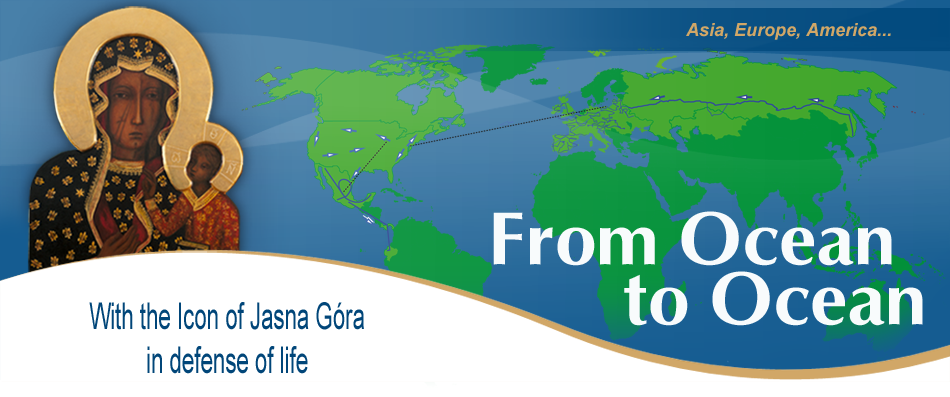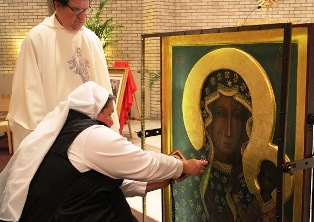Our Sorrowful Mother’s Ministry is a retreat center in Vandalia, Illinois within the Diocese of Springfield founded as a Private Diocesan Association of the Christian Faithful under Bishop Thomas John Paprocki. Debbie Pryor and Vanessa Keck founded Our Sorrowful Mother’s Ministry as a way to bring others closer to their Catholic faith. Over the years it has turned into a ministry of healing and reconciliation.
Wherever the Black Madonna goes she brings healing and reconciliation, which is why several ministries serving those who suffer from abortion have adopted Our Lady of Czestochowa as their patroness. During our pilgrimage, many have noted her seemingly sorrowful expression. The truth is, Our Lady mourns because of the sins of mankind and the lack of gratitude in the hearts of men for the sacrifice that her Divine Son made on the cross.
The Pilgrim Icon of Our Lady of Czestochowa arrived in Vandalia after stopping at St. Jane de Chantal Church in Chicago on Friday night. Sister Maria-Paulina had her heart set on bringing the Black Madonna to the South Side of Chicago after seeing her in Naples in February.
Sister Maria-Paulina promotes the Apostolate of Redemptive Suffering, which emphasizes the sanctity and value of redemptive suffering through prayer, advocacy and education with a specific focus on illness, the physically challenged and end-of-life care. Confined to a wheelchair due to her own suffering from illness, Sister played the organ for Our Lady’s visit and was greatly touched when we brought the icon close so she could venerate her.
Like many who attended the conference at Our Sorrowful Mother’s Ministry, we drove a long distance that night to arrive in Vandalia, which is about an hour east of St. Louis, MO. The speakers for the weekend of the Madonna’s visit included Bishop Thomas John Paprocki, Father West, Sr. Mary Claire OLM, and Linda Santo.
During her beautiful presentation on St. Faustina Kowalska and Divine Mercy, Sr. Mary Claire related a personal story about immigration difficulties as an Irish citizen living in the United States. She was not able to return to her native Ireland for years, until the problem was resolved. Each time she spoke to her elderly father, he always asked “When are you coming home?” She says Our Father in heaven has the same intense longing to be united with each of us and is always willing to forgive our sins. Thankfully, her problem was resolved and she was able to visit with her father before his death.
Linda Santos spoke about her daughter, Audrey who died in 2007 after 20 years confined to her bed following an accident in which Audrey almost drowned. Our Lady of Czestochowa can identify with suffering; in her icon, on one side of her face she has scars and her cheek appears to be swollen. The best mother imaginable, Our Lady always points to Jesus, Who always gives us strength to endure difficult times. Linda and family members provided loving care for Audrey and found the strength they needed in prayer to Jesus through invoking the loving intercession of the Blessed Virgin Mary.
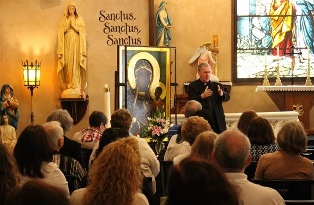 Fr. West gave several talks about the Icon of Our Lady of Czestochowa and the From Ocean to Ocean Pilgrimage in Defense of Life. He related the story of his vocation which is very bound up in devotion to the Blessed Virgin Mary and defending life. An important part of that story was a deepening of faith after reading a book about Our Lady of Fatima and his consecration to Jesus through Mary following the formula of St. Louis de Montfort. It was after reading the book about Fatima that Fr. West returned to the Sacrament of Confession as a young man. After making the consecration he first became involved in the pro-life movement. In God’s Providence, his vocation as a priest involves promoting devotion to Our Lady and preaching in defense of human life.
Fr. West gave several talks about the Icon of Our Lady of Czestochowa and the From Ocean to Ocean Pilgrimage in Defense of Life. He related the story of his vocation which is very bound up in devotion to the Blessed Virgin Mary and defending life. An important part of that story was a deepening of faith after reading a book about Our Lady of Fatima and his consecration to Jesus through Mary following the formula of St. Louis de Montfort. It was after reading the book about Fatima that Fr. West returned to the Sacrament of Confession as a young man. After making the consecration he first became involved in the pro-life movement. In God’s Providence, his vocation as a priest involves promoting devotion to Our Lady and preaching in defense of human life.
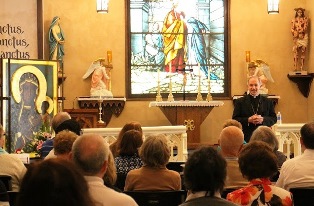 We were grateful that Bishop Paprocki took the time to speak at the conference. He spoke about his and his family’s longstanding devotion to Our Lady of Czestochowa and about the new evangelization. He encouraged the attendees to invite people to our church gatherings, pray, study the Catholic Faith, and perform good works in the service of others.
We were grateful that Bishop Paprocki took the time to speak at the conference. He spoke about his and his family’s longstanding devotion to Our Lady of Czestochowa and about the new evangelization. He encouraged the attendees to invite people to our church gatherings, pray, study the Catholic Faith, and perform good works in the service of others.
Bishop Paprocki reminded all during his talk that the link between faith and culture is inseparable. The current culture not only does not help to transmit the faith but is hostile to it. He held up the Polish people as an example for their ability to maintain their culture and preserve their identity despite attempts to suppress it by their oppressors. In the Third Partition of Poland in 1795, Poland was wiped off the face of the world map after it was split between Prussia, the Russian Empire and the Austrian Empire. The main reasons that Poland was able to pass her culture on along to following generations was due to her language and the Catholic faith. Devotion to Our Lady of Czestochowa is as important a part of Polish religious and national identity as Our Lady of Guadalupe is for Mexico.
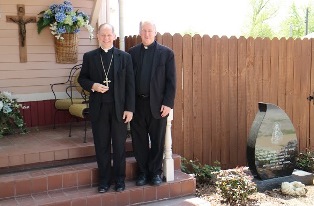 Bishop Paprocki also spoke about the interesting phenomenon in his native Chicago of Hispanics being attracted to parishes that were once formerly Polish, while African-Americans were more attracted to parishes that were formerly majority Irish. He speculated that the reason for this might be that in Polish parishes they already had a tradition of multi-lingual services. In his experience, Poles and Hispanics of course don’t see Our Lady of Czestochowa and Our Lady of Guadalupe as rivals. Rather, of course, she is the same Lady who appears to us in different forms.
Bishop Paprocki also spoke about the interesting phenomenon in his native Chicago of Hispanics being attracted to parishes that were once formerly Polish, while African-Americans were more attracted to parishes that were formerly majority Irish. He speculated that the reason for this might be that in Polish parishes they already had a tradition of multi-lingual services. In his experience, Poles and Hispanics of course don’t see Our Lady of Czestochowa and Our Lady of Guadalupe as rivals. Rather, of course, she is the same Lady who appears to us in different forms.
One interesting trend in Polish communities is the prevalence of cultural centers. We saw this at St. Eugene de Mazenod with the Millennium Center, which serves as a way to bring community together and evangelize through events and commerce. Through its daily activity it continues to keep alive and inculcate Polish culture and faith. Polonia North, another Polish cultural center, was a prime sponsor of the Black Madonna’s visit to Tottenham, Ontario. The Orchard Lake Schools in Michigan, which includes SS. Cyril & Methodius Seminary, trains Polish speaking seminarians helps pass on the Catholic faith along with Polish language and culture. Polish Youngstown helped bring the icon to Youngstown and Cleveland, Ohio. The Black Madonna also honored by a prominent place at the Pulaski Day Parade in New York City, which helps to promote Polish culture and identity. Bishop Emeritus John W. Yanta is planning on building a Polish cultural center in Panna Maria, Texas - the first Polish settlement in what is now the United States.
Although the Black Madonna is venerated in many different cultures, the From Ocean to Ocean Pilgrimage in Defense of Life helps remind people of the inseparable link between national identity, culture, the Catholic faith and traditional family values, as one sees in Polish communities. Of course, these are not only Polish values, but values upon which the preservation of society itself depends.
